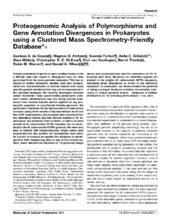| dc.contributor.author | De Souza, Gustavo A. | en_US |
| dc.contributor.author | Arntzen, Magnus Øverlie | en_US |
| dc.contributor.author | Fortuin, Suereta | en_US |
| dc.contributor.author | Schürch, Anita | en_US |
| dc.contributor.author | Målen, Hiwa | en_US |
| dc.contributor.author | McEvoy, Christopher R. | en_US |
| dc.contributor.author | Van Soolingen, Dick | en_US |
| dc.contributor.author | Thiede, Bernd | en_US |
| dc.contributor.author | Warren, Robin M. | en_US |
| dc.contributor.author | Wiker, Harald G. | en_US |
| dc.date.accessioned | 2013-02-22T09:23:56Z | |
| dc.date.available | 2013-02-22T09:23:56Z | |
| dc.date.issued | 2011-01 | eng |
| dc.Published | Molecular & Cellular Proteomics 10(1) | eng |
| dc.identifier.issn | 1535-9484 | |
| dc.identifier.issn | 1535-9476 | |
| dc.identifier.uri | https://hdl.handle.net/1956/6362 | |
| dc.description.abstract | Precise annotation of genes or open reading frames is still a difficult task that results in divergence even for data generated from the same genomic sequence. This has an impact in further proteomic studies, and also compromises the characterization of clinical isolates with many specific genetic variations that may not be represented in the selected database. We recently developed software called multistrain mass spectrometry prokaryotic database builder (MSMSpdbb) that can merge protein databases from several sources and be applied on any prokaryotic organism, in a proteomic-friendly approach. We generated a database for the Mycobacterium tuberculosis complex (using three strains of Mycobacterium bovis and five of M. tuberculosis), and analyzed data collected from two laboratory strains and two clinical isolates of M. tuberculosis. We identified 2561 proteins, of which 24 were present in M. tuberculosis H37Rv samples, but not annotated in the M. tuberculosis H37Rv genome. We were also able to identify 280 nonsynonymous single amino acid polymorphisms and confirm 367 translational start sites. As a proof of concept we applied the database to wholegenome DNA sequencing data of one of the clinical isolates, which allowed the validation of 116 predicted single amino acid polymorphisms and the annotation of 131 Nterminal start sites. Moreover we identified regions not present in the original M. tuberculosis H37Rv sequence, indicating strain divergence or errors in the reference sequence. In conclusion, we demonstrated the potential of using a merged database to better characterize laboratory or clinical bacterial strains. | en_US |
| dc.language.iso | eng | eng |
| dc.publisher | American Society for Biochemistry and Molecular Biology | eng |
| dc.title | Proteogenomic Analysis of Polymorphisms and Gene Annotation Divergences in Prokaryotes using a Clustered Mass Spectrometry-Friendly Database | en_US |
| dc.type | Peer reviewed | |
| dc.type | Journal article | |
| dc.description.version | publishedVersion | en_US |
| dc.rights.holder | Copyright 2011 by The American Society for Biochemistry and Molecular Biology, Inc | |
| dc.identifier.doi | https://doi.org/10.1074/mcp.m110.002527 | |
| dc.identifier.cristin | 348228 | |
| dc.source.journal | Molecular & Cellular Proteomics | |
| dc.source.40 | 10 | |
| dc.source.14 | 1 | |
